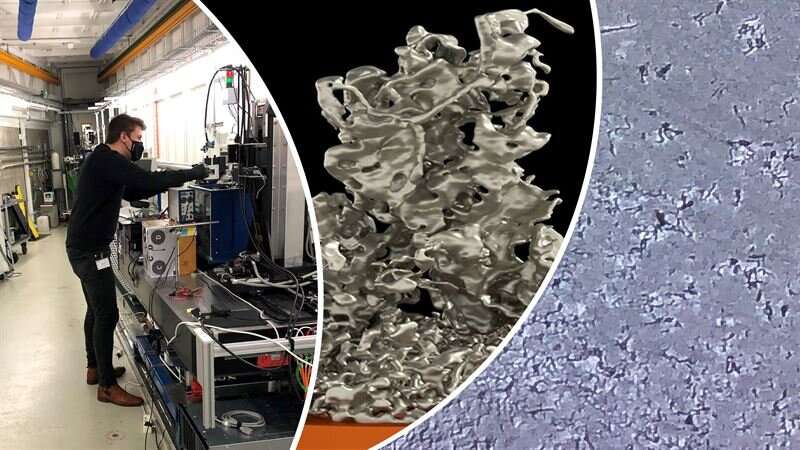This article has been reviewed according to Science X's editorial process and policies. Editors have highlighted the following attributes while ensuring the content's credibility:
fact-checked
peer-reviewed publication
trusted source
proofread
3D battery imaging reveals the secret real-time life of lithium metal cells

Innovative battery researchers have cracked the code to creating real-time 3D images of the promising but temperamental lithium metal battery as it cycles. A team from Chalmers University of Technology, Sweden, have succeeded in observing how the lithium metal in the cell behaves as it charges and discharges.
The new method may contribute to batteries with higher capacity and increased safety in our future cars and devices.
"We've opened a new window in order to understand—and in the long term to optimize—the lithium metal batteries of the future. When we can study exactly what happens to the lithium in a cell during cycling, we gain important knowledge of what affects its inner workings," says Aleksandar Matic, professor at the Department of Physics at Chalmers and head of the scientific study that was recently published in Nature Communications.
There are high hopes that new battery concepts, such as lithium metal batteries, will be able to replace today's lithium-ion batteries. The goal is to develop more energy-dense and safer batteries that will take us further at a lower cost—both financially and environmentally. Solid-state batteries, lithium-sulfur batteries and lithium-oxygen batteries are among those being held up as promising alternatives. All of these concepts build on the idea that the battery anode, consists of a lithium metal instead of the graphite that is in today's batteries. Without graphite, the battery cell will be lighter, and with lithium metal as the anode it will also be possible to use high-capacity cathode materials. This makes it possible to achieve three to five times the energy density.
Lithium forms undesired microstructures
However, lithium metal batteries have one crucial problem: when battery is charged or discharged, the lithium does not always deposit as flat and smooth as it should. Often, it forms mossy microstructures or dendrites, long needle like structures , and parts of the deposited lithium can become isolated and are then inactive. Dendrites, also risk reaching the other battery electrode and cause a short circuit. Therefore, it is crucial to understand when, how and why these structures form.
"To be able to use this technology in the next generation of batteries, we need to see how a cell is affected by factors such as current density, the choice of electrolyte and the number of cycles. Now we have a tool to do so," says Chalmers researcher Matthew Sadd, head author of this new study along with his colleague Shizhao Xiong.
Excited wait for the first glimpse
The experiment to observe the formation of lithium microstructures in a working cell was conducted at the Swiss Light Source outside Zurich in Switzerland. In breathless anticipation, the researchers prepared a specially designed battery cell to study when lithium is deposited, in real time and in 3D using X-ray tomographic microscopy. Although many researchers have wanted to study lithium metal in a working cell, no one had been able to do so as far as the team knew. If they succeeded, it would be a major step forward, compared with analyzing images after a cell has been cycled.
"It was magical when we saw with our own eyes that it worked on the first attempt," Matic said. "When we observed the lithium creating big structures, like huge needles, it was almost like being in a lunar landing project. We've been wanting to observe the inner workings of batteries in real time for so long. And now we can."
Key piece of the puzzle for large-scale use
Now the research team aims to test the technique on other battery concepts, hoping that the necessary imaging technology will be available closer to home, for example at the Swedish MAX IV lab, a national research facility for advanced X-ray experiments.
"We're looking forward to developing this method to take faster measurements at higher resolution to see more detailed microstructures formed early on in the deposition process," Matic says. "This is a key piece of the puzzle to be able to use lithium metal batteries on a large scale and make them safe. A lot of research teams and companies are looking at the lithium metal concept for their future prototypes."
More information: Matthew Sadd et al, Investigating microstructure evolution of lithium metal during plating and stripping via operando X-ray tomographic microscopy, Nature Communications (2023). DOI: 10.1038/s41467-023-36568-z

















